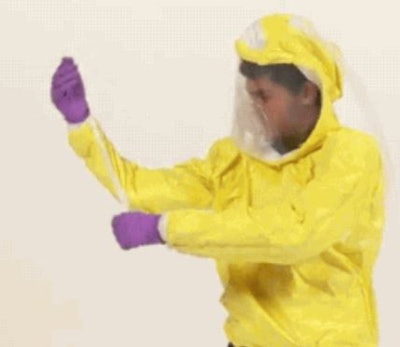
Here’s an idea for a smarter business suit, if your business is fighting Ebola or some other deadly infectious disease.
The suit was designed by a team from Johns Hopkins University in Baltimore, Md., that included students, engineers, medical and public health specialists, an architect, and even fashion and costume designers. Doctors, nurses and other medical workers can shed it in a few simple steps and better protect themselves from infected blood, vomit, diarrhea and other bodily fluids that may carry the Ebola virus. It also keeps them cooler and more comfortable, allowing them to work longer without needing to remove the garment.
“The reduction in the number of steps and their complexity was a key criteria for the suit,” says Richard Lamporte, vice president for development at Jhpiego [Jah-Pie-Go], a Johns Hopkins-affiliated nonprofit working on international health problems that was involved in the effort. “We are able to get it down from the average of 20 existing steps to at least seven, and as low as five.”
The Ebola epidemic has so far infected more than 18,600 people and killed 6,900. Among them were 649 healthcare workers who caught the virus and 349 who died as of Dec. 14, according to the World Health Organization.
This hurts on multiple levels. Although all nations need more qualified health workers, the shortage is especially acute in West Africa. The medical personnel deaths mean that Ebola will likely leave its fingerprints on the region for years after the outbreak will have passed.
Ever since the world began mobilizing against Ebola earlier this year, responders have struggled with properly donning and doffing their personal protective equipment.
The new suit makes the process easier. Its hood, face shield and gloves are fully integrated into the rest of the suit. There is also an air intake system that reduces shield fogging and dries the air being sucked in to keep the wearer cooler. The suit has zippers that curl outward to help keep potentially contaminated outer surfaces away from the wearer, and tabs that help the wearer slip out of the garment more easily and without making contact with outer coverings.
Lamporte says that hood was one of the most important elements. “That’s the first thing that you want to take off,” he says. “There have been many iterations. It is designed to allow workers to stay in the hot zone longer without the risk of fainting.”
The suit is made from Tychem, a heavy-duty version of DuPont’s Tyvek “house wrapping” material. It comes with a compression base layer made from a technical material that wicks moisture from the body and tricks it into sweating less. “This lowers dehydration, hopefully reducing the time it takes to recover from a 40 minute shift, which currently could take anywhere from 2 to 3 hours,” Lamporte says.
Existing suits, including models made in China, can cost around $30. Lamporte says the Hopkins team is aiming at a similar price range and using “frugal engineering” to hit the sweet spot where the lowest cost and the highest performance meet. He says that if workers will be able to stay inside the suits longer, then the number of times they need to change them will also drop.
The cross-disciplinary team that designed the suit first met in Baltimore in October. The suit has already earned the team a spot among five finalists of the “Grand Challenge” competition to fight Ebola, which was organized by the U.S. Agency for International Development. The team will use USAID funding to move the prototype closer to mass production.
“If ever there was a public health crisis that merits the finest science, medicine and innovation the world has to offer, it is this one,” said Leslie Mancuso, Jhpiego’s head.
GE Foundation has provided funding for Jhpiego, which is working with Hopkins’ CBID on projects related to Ebola. The foundation is also backing other Ebola initiatives, both in the U.S. and in Africa.

For more articles like this, visit GE Reports.






















